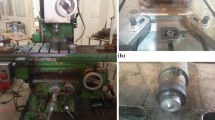Abstract
In this paper, AA 2024 T3-rolled sheets were joined in butt joint configuration through the friction stir welding process. Different joints were carried out varying the principal process parameters (i.e., tool welding speed and tool rotational speed). The aim of this work was the study and the experimental characterization of the influence of the process parameters on the forces acting on the tool during the FSW process. Furthermore, it was studied the correlation between the forces and the grain size, in particular with the extension of the heat-affected zone. Forces acting along the axis parallel to the tool are actually greater than those acting along welding direction. All the recorded forces are strictly dependant on the process parameters adopted. No correlation has been found between the grain dimension within the weld bead and the recorded forces, while the greater the forces, the narrower the extension of the heat-affected zone.













Similar content being viewed by others
References
R.S. Mishra, Z.Y. Ma, Friction Stir Welding and Processing, Materials Science and Engineering: R: Reports, 2005
A. Squillace, A. De Fenzo, G. Giorleo, and F. Bellucci, A Comparison Between FSW and TIG Welding Techniques: Modifications of Microstructure and Pitting Corrosion Resistance in AA 2024-T3 Butt Joints, J. Mater. Process. Technol., 2004, 152(1), p 97–105
A. Astarita, A. Squillace, E. Armentani, and S. Ciliberto, Friction stir welding of AA 2198 T3 rolled sheets in butt configuration, Metall. Ital., 2012, 104(7–8), p 31–40
G. Buffa, L. Fratini, J. Hua, and R. Shivpuri, Friction Stir Welding of Tailored Blanks: Investigation on Process Feasibility, CIRP Ann. Manuf. Technol., 2006, 55(1), p 279–282
P. Ulysse, Three-Dimensional Modelling of the Friction Stir Welding Process, Int. J. Mach. Tools Manuf, 2002, 42, p 1549–1557
P.A. Colegrove and H.R. Shercliff, 2-Dimensional CFD Modelling of Flow Round Profiled FSW Tooling, Sci. Technol. Weld. Join., 2004, 9, p 483–492
G. Buffa, J. Hua, R. Shivpuri, and L. Fratini, A Continuum Based FEM Model for Friction Stir Welding-Model Development, Mater. Sci. Eng. A, 2006, 419, p 389–396
M. Melendez, W. Tang, C. Schmidt, J. C. McClure, A. C. Nunes, L. E. Murr Tool Forces Developed during Friction Stir Welding, Nasa Technical Reports Server, Document ID: 20030071631, 2003
Y. Yang, P. Kalya, R. Landers, and K. Krishnamurthy, Automatic Gap Detection in Friction Stir Butt Welding Operations, Int. J. Mach. Tools Manuf., 2008, 48, p 1161–1169
S. Mandal and J. Rice, Experimental and Numerical Investigation of the Plunge Stage in Friction Stir Welding, J. Mater. Process. Technol., 2008, 203, p 411–419
H. Badarinarayan, Y. Shi, X. Li, and K. Okamoto, Effect of Tool Geometry on Hook Formation and Static Strength of Friction Stir Spot Welded Aluminium 5754-0 Sheets, Int. J. Mach. Tools Manuf., 2009, 49, p 814–823
S. Ciliberto, A. Astarita, and A. Squillace, FSW of T Joints in Overlap Configuration: Process Optimization in Joining Dissimilar Aluminium Alloys for the Aeronautic Application, Surf. Interface Anal, 2013, doi:10.1002/sia.5214
G. Bussu and P.E. Irving, The Role of Residual Stress and Heat Affected Zone Properties on Fatigue Crack Propagation in Friction Stir Welded 2024-T351 Aluminium Joints, Int. J. Fatigue, 2003, 25, p 77–88
C.M. Chen and R. Kovacevic, Finite Element Modeling of Friction Stir Welding—Thermal and Thermomechanical Analysis, Int. J. Mach. Tools Manuf., 2003, 43(13), p 1319–1326
P. Carlone and G.S. Palazzo, Influence of Process Parameters on Microstructure and Mechanical Properties in AA2024-T3 Friction Stir Welding, Metallogr. Microstruct. Anal., 2013, 2(4), p 213–222
E. Lertora, Comparison of AA 2024 T3 Friction Stir Welded and Riveted Overlap Joints with the Addition of a Pressurization Test, Mater. Des., 2013, 49, p 259–266
K.V. Jata and S.L. Semiatin, Continuous Dynamic Recrystallization During Friction Stir Welding of High Strength Aluminum Alloys, Scr. Mater., 2000, 43, p 743–749
M.A. Sutton, A.P. Reynolds, B. Yang, and R. Taylor, Mode I, Fracture and Microstructure for 2024-T3 Friction Stir Welds, Mater. Sci. Eng., 2003, 354, p 6–16
A.S. Franchim, F.F. Fernandez, and D.N. Travessa, Microstructural Aspects and Mechanical Properties of Friction Stir Welded AA2024-T3 Aluminum Alloy Sheet, Mater. Des., 2011, 32, p 4684–4688
A. Astarita, A. Squillace, A. Scala, and A. Prisco, On the Critical Technological Issues of Friction Stir Welding T-Joints of Dissimilar Aluminum Alloys, J. Mater. Eng. Perform, 2012, 21, p 1763–1771. doi:10.1007/s11665-011-0073-3
C. Bitondo, U. Prisco, A. Squilace, P. Buonadonna, and G. Dionoro, Friction-Stir Welding of AA 2198 Butt Joints: Mechanical Characterization of the Process and of the Welds Through DOE Analysis, Int. J. Adv. Manuf. Technol., 2011, 53, p 505–516. doi:10.1007/s00170-010-2879-9
P. Cavaliere, R. Nobile, F.W. Panella, and A. Squillace, Mechanical and Microstructural Behaviour of 2024–7075 Aluminium Alloy Sheets Joined by Friction Stir Welding, Int. J. Mach. Tools Manuf., 2006, 46, p 588–594
M. Assidi, L. Fourment, S. Guerdoux, and T. Nelson, Friction Model for Friction Stir Welding Process Simulation: Calibrations from Welding Experiments, Int. J. Mach. Tools Manuf., 2010, 50, p 143–155
A. Arora, M. Mehta, A. De, and T. DebRoy, Load Bearing Capacity of Tool Pin During Friction Stir Welding, Int. J. Adv. Manuf. Technol., 2012, 61, p 911–920. doi:10.1007/s00170-011-3759-7
J. Trimble and G.E. Monaghan, O’Donnell Force Generation During Friction Stir Welding of AA2024-T3 D, CIRP Ann. Manuf. Technol., 2012, 61, p 9–12
H. Su, C.S. Wu, A. Pittner, and M. Rethmeier, Simultaneous Measurement of Tool Torque, Traverse Force and Axial Force in Friction Stir Welding, J. Manuf. Process., 2013, 15, p 495–500
R. Kumar, K. Singh, and S. Pandey, Process Forces and Heat Input as Function of Process Parameters in AA5083 Friction Stir Welds, Trans. Nonferrous Met. Soc. China, 2012, 22, p 288–298
Author information
Authors and Affiliations
Corresponding author
Rights and permissions
About this article
Cite this article
Astarita, A., Squillace, A. & Carrino, L. Experimental Study of the Forces Acting on the Tool in the Friction-Stir Welding of AA 2024 T3 Sheets. J. of Materi Eng and Perform 23, 3754–3761 (2014). https://doi.org/10.1007/s11665-014-1140-3
Received:
Revised:
Published:
Issue Date:
DOI: https://doi.org/10.1007/s11665-014-1140-3




